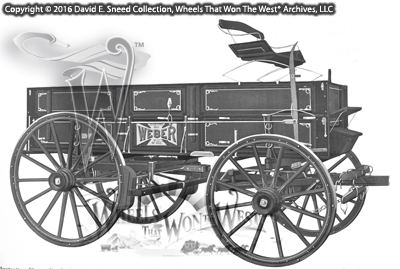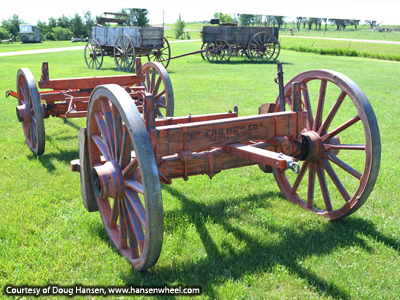From the moment the first wheel was built in America, there was a need in every community for reliable transportation. In fact, period records focused on the wagon and carriage trade make it clear that vehicles for personal and business purposes were highly sought after. As it turns out, some of the most legendary wagon makers were originally based in Chicago, Illinois. Among the more notable brands are Peter Schuttler, Weber, Louis Palm, and Columbus. Even Henry Mitchell (Mitchell Wagons) who ultimately made Racine, Wisconsin his home, started out in Chicago. Of course, St. Louis often receives accolades as a major center for early transportation and the city certainly deserves the 'Gateway to the West' moniker. However, Chicago was no stranger to the vehicle industry either, claiming more than 200 wagon and carriage makers during the heyday of horse-drawn vehicle making.
With the U.S. economy supporting tens of thousands of vehicle builders in both the nineteenth and early twentieth centuries, understanding all there is to know about just one manufacturer can be tough. Yet, having an awareness of who did what, when, where, how, and why is just part of the role of any historian. For me, it's also been helpful in the evaluation process for vehicle purchases.
A good deal of information that supports this process is contained in the original catalog collection housed in the Wheels That Won The West® Archives. Even so, there are often gaps in tracking builders from year-to-year. Those historians and collectors that do search for period literature know that finding wagon-maker brochures from a time just prior to the turn of the twentieth century can be a challenge. Finding even earlier catalogs published before the 1890's requires an extra dose of patience. They are rarely found. Looking even farther back in time, catalogs and promotional literature connected to the days of America's Centennial or earlier are practically non-existent. The result is that, when conducting research during these eras, we often have to rely on books, newspapers, and other accounts printed during the periods.
To that point, I spend a fair amount of time rooting out forgotten facts wherever they can be found. So it was that I recently came across a pre-Civil War story highlighting wagon makers in Chicago. The article gives us some insights into a number of builders who saw and supported so much of America's westward migration. One example is the Weber Wagon Company. After only a decade or so in business, it appears that, Henry Weber's business was still relatively small. In fact, prior to the1860's, Weber is said to have employed around 18 workers while finishing 200 wagons per year. Even though the company built quality products, the earliest production numbers were quite modest, especially compared to the growth experienced after International Harvester bought the brand in 1904.
 |
| Certain elements of Weber's logo design and construction features were changed after the brand was purchased by International Harvester in 1904. |
In contrast to Weber, after roughly a decade in business, the Peter Schuttler Wagon Company was a beehive of activity. Its popularity was clear for all to see. In fact, during this part of the 19th century, the brand was producing some 1800 (largely hand-built) wagons per year while employing at least a hundred men. Many Schuttler wagons were sold to Mormons moving West at the time. From employment to production, by the 1850's, Schuttler was already more than 5 times larger than Weber. It's a point further reinforced by period accounts pointing to Schuttler as the largest factory serving the western trade at the time. (For a look at what they were building during these years, see my article on the Steamboat Arabia find on our website. I also wrote an even more detailed look on this 1856 Schuttler in the January 2008 issue of the Carriage Journal magazine.)

Locating original wagons with large amounts of original paint is an increasingly difficult task. This Peter Schuttler running gear at hansenwheel.com is a rare find.
By the mid 1850's, the city of Chicago was just under twenty years old. Its population had swelled to near 80,000 and it was supported by less than a hundred vehicle builders - many of them of Germans who had yet to learn the English language. Quality, though, is a universal language. As folks saw the craftsmanship, attention to detail, and dependability of certain makes, they clamored for more. The value packed into so many of these early icons was clear with the result being that, still today, the Peter Schuttler and Weber brands remain highly desirable to early vehicle collectors. Even so, it's difficult to find a Weber wagon built prior to the company's purchase by International Harvester. Nonetheless, from promotional trinkets and signage to the vehicles, themselves, collectors continue to scour the country looking for survivors that started out in Chicago.
Please Note: As with each of our blog writings, all imagery and text is copyrighted with All Rights Reserved. The material may not be broadcast, published, rewritten, or redistributed without prior written permission from David E. Sneed, Wheels That Won The West® Archives, LLC